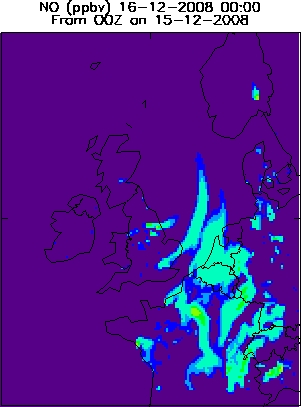Difference between revisions of "Air Quality Forecasting"
(→AQUM - Air Quality in the Unified Model: major upate of content) |
|||
| Line 3: | Line 3: | ||
[[Image:NO_AQUM.jpg|thumb|right|NO from AQUM]] |
[[Image:NO_AQUM.jpg|thumb|right|NO from AQUM]] |
||
| + | The Met Office now performs a daily 48 hour air quality forecast using a limited area version of UKCA. |
||
| − | Work is currently ongoing at the Met Office to begin air quality forecasting using a version of UKCA. Code for making lateral boundary conditions with tracers included, a more extensive tropospheric chemistry scheme and a suite for performing forecasting in an operational test are under development. |
||
| − | The |
+ | The model grid has 12km horizontal resolution with a domain which covers all of the UK and was until 2006 used for operational weather forecasting. It includes aerosol as well as gas phase pollutants. The initial meteorological conditions and meterological variables at the model edges come from the Met Office's 12km North Atlantic and European Model. The values of chemical and aerosol tracers at the model edges come from daily global forecasts carried out as part of the MACC project. |
| + | |||
| + | Recently output from the AQUM model was used to help flight planning for two recent NERC aircraft campaigns in the UK and it is now planned to use these flights for model evaluation and scientific investigations. A year long run of the AQUM model has now also been carried out for participation in a model intercomparison experiment. |
||
Revision as of 15:48, 18 November 2010
AQUM - Air Quality in the Unified Model
The Met Office now performs a daily 48 hour air quality forecast using a limited area version of UKCA.
The model grid has 12km horizontal resolution with a domain which covers all of the UK and was until 2006 used for operational weather forecasting. It includes aerosol as well as gas phase pollutants. The initial meteorological conditions and meterological variables at the model edges come from the Met Office's 12km North Atlantic and European Model. The values of chemical and aerosol tracers at the model edges come from daily global forecasts carried out as part of the MACC project.
Recently output from the AQUM model was used to help flight planning for two recent NERC aircraft campaigns in the UK and it is now planned to use these flights for model evaluation and scientific investigations. A year long run of the AQUM model has now also been carried out for participation in a model intercomparison experiment.
